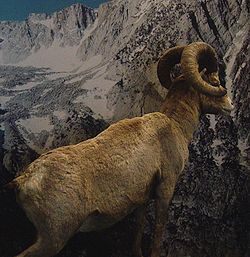- Sierra Nevada bighorn sheep
-
Sierra Nevada bighorn sheep 
Stuffed male in the Mono Lake visitors center. Conservation status Scientific classification Kingdom: Animalia Phylum: Chordata Class: Mammalia Order: Artiodactyla Family: Bovidae Subfamily: Caprinae Genus: Ovis Species: O. canadensis Subspecies: O. c. sierrae Trinomial name Ovis canadensis sierrae
(Grinnell, 1912)Sierra Nevada bighorn sheep (Ovis canadensis sierrae) is a subspecies of bighorn sheep. Early taxonomic schemes included herds from British Columbia to southern California in a broader subspecies Ovis canadensis californiana. More recent genetic testing has indicated that O. c. californiana consists of only a small population located in the southern and central Sierra Nevada, hence should be renamed Ovis canadensis sierrae.[2]
Habitat and behaviors
Sierra Nevada bighorn sheep inhabit portions of the Sierra Nevada located along the eastern boundary of California in Tuolumne, Mono, Fresno, Inyo, and Tulare Counties. Habitat occurs from the eastern base of the range as low as 4,790 feet (1,460 m) to peaks above 14,100 feet (4,300 m). Sierra Nevada bighorn sheep inhabit open areas where the land is rocky, sparsely vegetated, and characterized by steep slopes and canyons. Wehausen[3] provides a detailed description of Sierra Nevada bighorn sheep habitat throughout its range. They prefer open ground to better detect predators and allow enough time to reach steep, rocky terrain (escape habitat). Forests and thick brush are usually avoided if possible.[4]
Most of the sheep live at higher elevations 10,000–14,000 feet (3,000–4,300 m) in subalpine and alpine areas during the summer. During winter, these sheep occupy high-elevation, windswept ridges and tend to prefer south-facing slopes where snow melts more readily or migrate to lower elevations (4,800 ft (1,500 m)) in sagebrush-steppe areas to avoid deep snow and to find forage.[4]
Sierra Nevada bighorn sheep are gregarious, with group size and composition depending on gender and season. Spatial segregation by gender occurs outside of the mating season. Bighorn sheep ewes generally remain with the same band in which they were born. Males older than 2 years of age remain apart from females and younger males for most of the year. During the late fall and winter, the groups come together and concentrate in suitable winter habitat. Breeding takes place in late fall, generally November and December. Lambing occurs between late April and early July on safe, precipitous, rocky slopes; most lambs in the Sierra Nevada are born in May and June. Ewes and lambs often occupy steep terrain that provides a diversity of exposures and slopes for escape cover. The lifespan for both Sierra Nevada bighorn sheep males and females has been observed as 8 to 12 years.[4]
Bighorn sheep are primarily diurnal. They are primarily grazers; however, they may browse woody vegetation at times. Plants consumed include various grasses, browse, and forbs, depending on season and location. Naturally occurring mineral licks provide necessary minerals for bone and muscle growth.[4]
Species recovery
Sierra Nevada bighorn sheep were listed as an endangered species on January 3, 2000, following emergency listing on April 20, 1999.[5] In 1995, these genetically distinct Bighorn Sheep hit a population low of about 100 total individuals, distributed across 5 separate areas of the southern and central Sierra Nevada, and had increased to about 125 in 1999. Since then conditions have been particularly favorable for population growth, with the total number of individuals reaching about 250 as of 2002.[6] Significant population declines beginning in the late 1980s were associated with the bighorn sheep avoiding low elevation winter ranges.
The Nevada Department of Wildlife estimates that there are 1500 California bighorn sheep located in northwestern Nevada as of 2004.[7] However this population appears to be genetically distinct from the Sierra Nevada population, and may be more properly classified as Desert Bighorn Sheep (O. c. nelsoni).
References
- ^ "Sierra Nevada Bighorn sheep (Ovis canadensis sierrae) species profile". Environmental Conservation Online System. United States Fish and Wildlife Service. March 3, 2010. http://ecos.fws.gov/speciesProfile/profile/speciesProfile.action?spcode=A0DS.
- ^ Wehausen, J.D.; V.C. Bleich, R.R. Ramey II (2005). "Correct Nomenclature for Sierra Nevada Bighorn Sheep". California Fish and Game 91 (3): 216–218. http://www.wmrs.edu/people/BIOs/john%20wehausen/bighorn%20nomenclature.pdf. Retrieved 2006-07-16.
- ^ Wehausen, J.D. (1980). Sierra Nevada bighorn sheep: history and population ecology (Ph.D. thesis). Univ. Michigan, Ann Arbor. pp. 18–25.
- ^ a b c d
 This article incorporates public domain material from the Fish and Wildlife Service document "Designation of Critical Habitat for the Sierra Nevada Bighorn Sheep (Ovis canadensis sierrae) and Taxonomic Revision; Final Rule" (73 F.R. 45533).
This article incorporates public domain material from the Fish and Wildlife Service document "Designation of Critical Habitat for the Sierra Nevada Bighorn Sheep (Ovis canadensis sierrae) and Taxonomic Revision; Final Rule" (73 F.R. 45533). - ^ "US Fish and Wildlife Service endangered species recovery plan for the Sierra Nevada Bighorn Sheep". http://ecos.fws.gov/docs/recovery_plans/2003/030730.pdf. Retrieved 2005-06-13.
- ^ "Sierra Nevada Bighorn Sheep Recovery Report 2003". http://www.dfg.ca.gov/ocal/archives/bighorn_sheep_jf04.pdf. Retrieved 2006-11-17.
- ^ "About NDOW Fast Facts". http://www.ndow.org/about/facts/. Retrieved 2006-11-17.
Categories:- Ovis
- Endemic fauna of California
- Fauna of the Sierra Nevada (U.S.)
- Mammals of the United States
Wikimedia Foundation. 2010.

